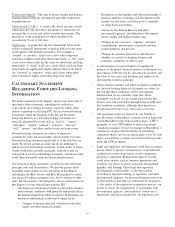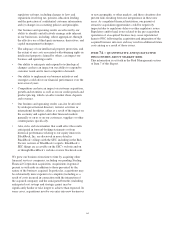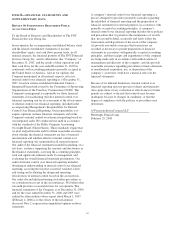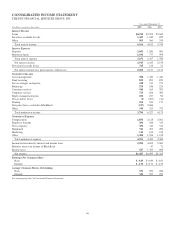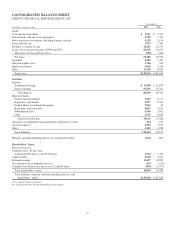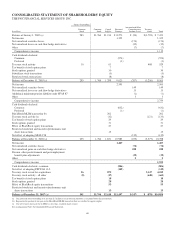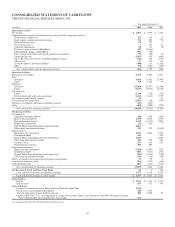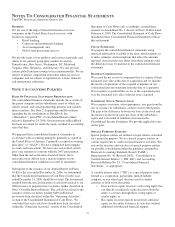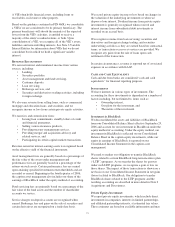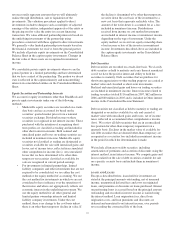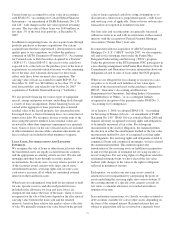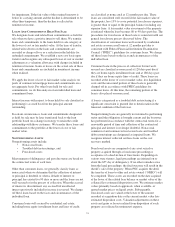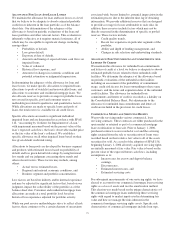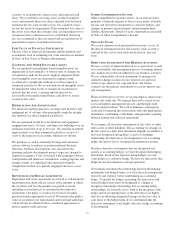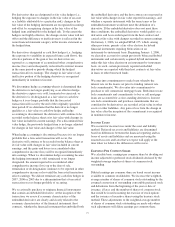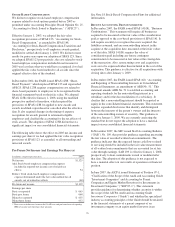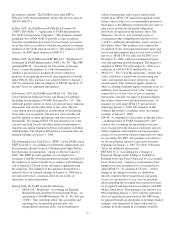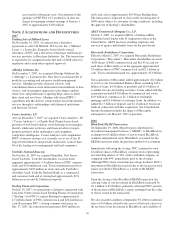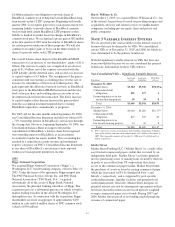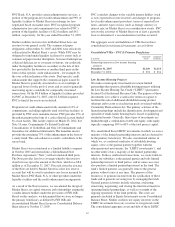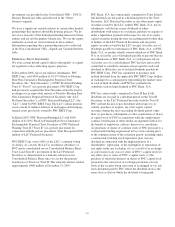PNC Bank 2007 Annual Report Download - page 78
Download and view the complete annual report
Please find page 78 of the 2007 PNC Bank annual report below. You can navigate through the pages in the report by either clicking on the pages listed below, or by using the keyword search tool below to find specific information within the annual report.Certain loans are accounted for at fair value in accordance
with SFAS 155, “Accounting for Certain Hybrid Financial
Instruments – an amendment of FASB Statements No. 133
and 140,” with changes in the fair value reported in trading
revenue. The fair value of these loans was $149 million, or
less than .5% of the total loan portfolio, at December 31,
2007.
In addition to originating loans, we also acquire loans through
portfolio purchases or business acquisitions. For certain
acquired loans that have experienced a deterioration of credit
quality prior to our acquisition, we follow the guidance
contained in AICPA Statement of Position 03-3, “Accounting
for Certain Loans or Debt Securities Acquired in a Transfer”
(‘SOP 03-3’). Under SOP 03-3, the excess of the cash flows
expected to be collected over the purchase price of the loan at
acquisition is accreted into interest income over the remaining
life of the loan. Any valuation allowance for these loans
reflect only those losses incurred after acquisition. The
carrying value of loans accounted for under SOP 03-3 at
December 31, 2007 was $43 million, or less than .5% of the
total loan portfolio, and related to our October 26, 2007
acquisition of Yardville National Bancorp (“Yardville”).
We also provide financing for various types of equipment,
aircraft, energy and power systems, and rolling stock through
a variety of lease arrangements. Direct financing leases are
carried at the aggregate of lease payments plus estimated
residual value of the leased property, less unearned income.
Leveraged leases, a form of financing lease, are carried net of
nonrecourse debt. We recognize income over the term of the
lease using the interest method. Lease residual values are
reviewed for other-than-temporary impairment on a quarterly
basis. Gains or losses on the sale of leased assets are included
in other noninterest income while valuation adjustments on
lease residuals are included in other noninterest expense.
L
OAN
S
ALES
,S
ECURITIZATIONS
A
ND
R
ETAINED
I
NTERESTS
We recognize the sale of loans or other financial assets when
the transferred assets are legally isolated from our creditors
and the appropriate accounting criteria are met. We also sell
mortgage and other loans through secondary market
securitizations. In certain cases, we may retain a portion or all
of the securities issued, interest-only strips, one or more
subordinated tranches, servicing rights and, in some cases,
cash reserve accounts, all of which are considered retained
interests in the transferred assets.
When loans are redesignated from held for investment to held
for sale, specific reserves and allocated pooled reserves
included in the allowance for loan and lease losses are
charged-off and reduce the basis of the loans. Gains or losses
recognized on the sale of the loans depend on the allocation of
carrying value between the loans sold and the retained
interests, based on their relative fair market values at the date
of sale. We generally estimate fair value based on the present
value of future expected cash flows using assumptions as to
discount rates, interest rates, prepayment speeds, credit losses
and servicing costs, if applicable. Gains or losses on loan sales
transactions are reported in noninterest income.
Our loan sales and securitizations are generally structured
without recourse to us and with no restrictions on the retained
interests with the exception of Federal National Mortgage
Association (“Fannie Mae”) loan sales.
In connection with our acquisition of ARCS Commercial
Mortgage Co., L.P. (“ARCS”) in July 2007, we also originate,
sell and service mortgage loans under the Fannie Mae
Delegated Underwriting and Servicing (“DUS”) program.
Under the provisions of the DUS program, PNC participates in
a loss-sharing arrangement with Fannie Mae. Refer to Note 24
Commitments and Guarantees for more information about our
obligations related to sales of loans under the DUS program.
When we are obligated for loss-sharing or recourse in a sale,
our policy is to record such liabilities at fair value upon
closing of the transaction based on the guidance contained in
FIN 45, “Guarantor’s Accounting and Disclosure
Requirements for Guarantees, Including Indirect Guarantees
of Indebtedness of Others,” or as a contingent liability
recognized at inception of the guarantee under SFAS No. 5,
“Accounting for Contingencies.”
As of January 1, 2006, we adopted SFAS 156, “Accounting
for Servicing of Financial Assets – an amendment of FASB
Statement No. 140.” SFAS 156 was issued in March 2006 and
requires all newly recognized servicing rights and obligations
to be initially measured at fair value. For subsequent
measurement of the asset or obligation, the standard permits
the election of either the amortization method or the fair value
measurement method by class of recognized servicing rights
and obligations. For servicing rights and obligations related to
commercial loans and commercial mortgages, we have elected
the amortization method. This method requires the
amortization of the servicing assets or liabilities in proportion
to and over the periods of estimated net servicing income or
net servicing loss. For servicing rights or obligations related to
residential mortgage loans, we have elected the fair value
method, with changes in the value of the right or obligation
reflected in noninterest income.
Each quarter, we analyze our servicing assets carried at
amortized cost for impairment by categorizing the pools of
assets underlying the servicing rights into various stratum. If
the carrying amount of a specific asset category exceeds its
fair value, a valuation allowance is recorded and reduces
noninterest income.
In securitization transactions, we classify securities retained as
debt securities available for sale or other assets, depending on
the form of the retained interest. Retained interests that are
subject to prepayment risk are reviewed on a quarterly basis
73


